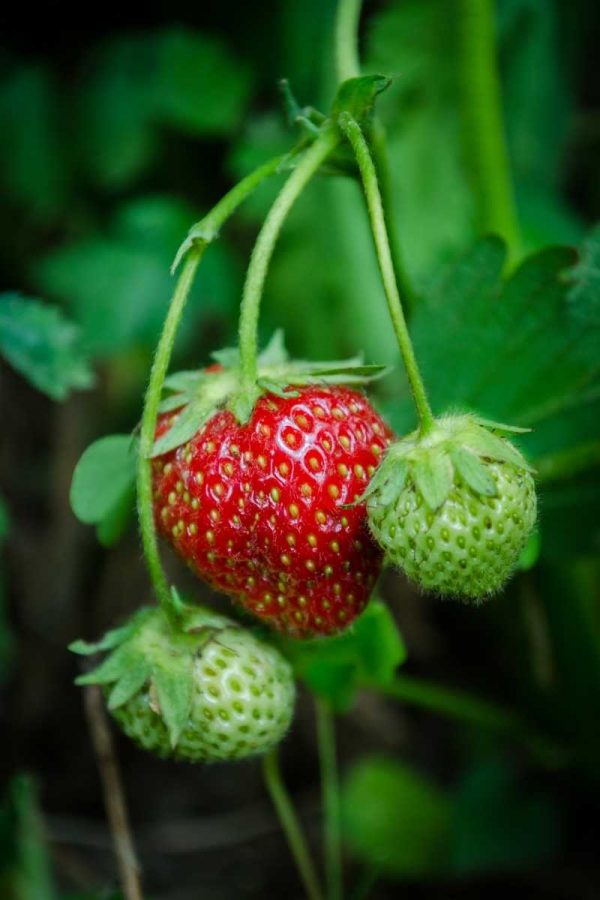Download Printable Strawberry Growing Guide »
Once they master the classic garden veggies—like tomatoes and cucumbers—most folks turn their thoughts toward adding fruit to their home garden. The first fruit many gardeners want to tackle? Strawberries!
Strawberries are an excellent crop for your home garden. They are relatively easy to take care of, they come back year after year, and they produce some of the earliest fruits in the garden. We know growing your first perennial fruit can feel intimidating, but we promise anyone can grow strawberries! Let’s get growing.
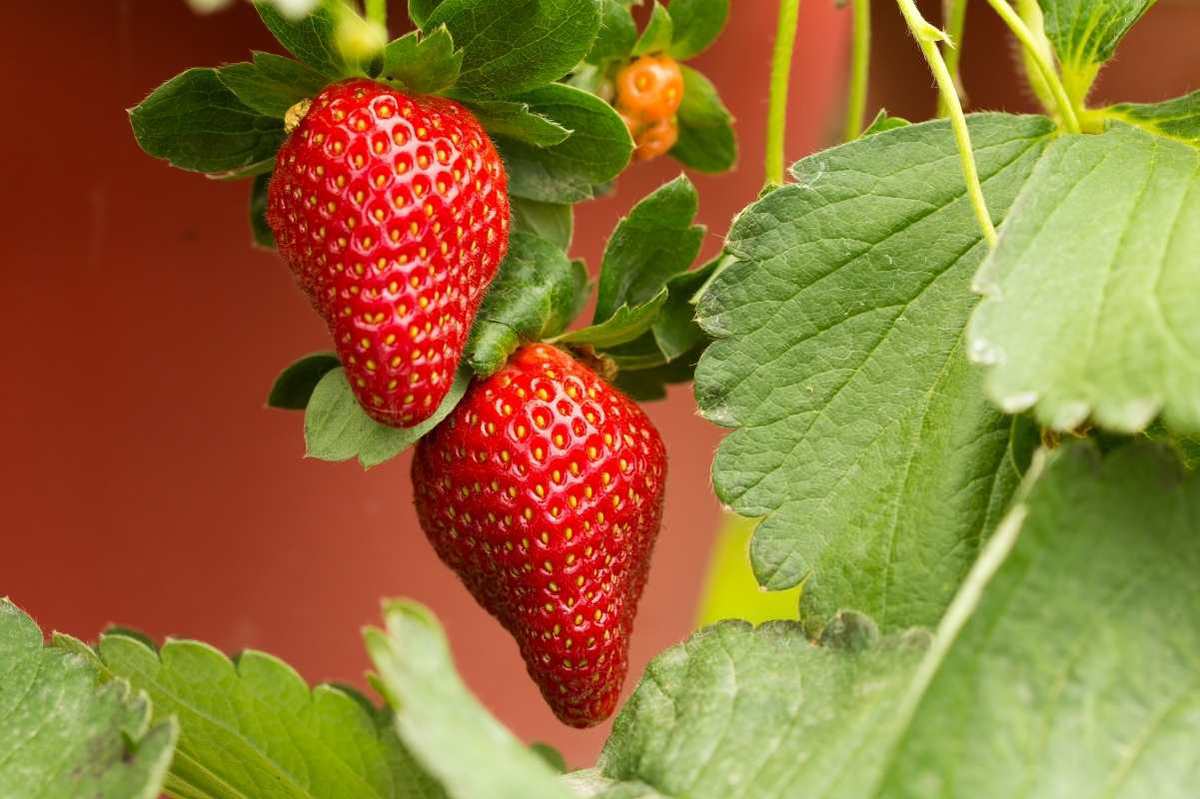
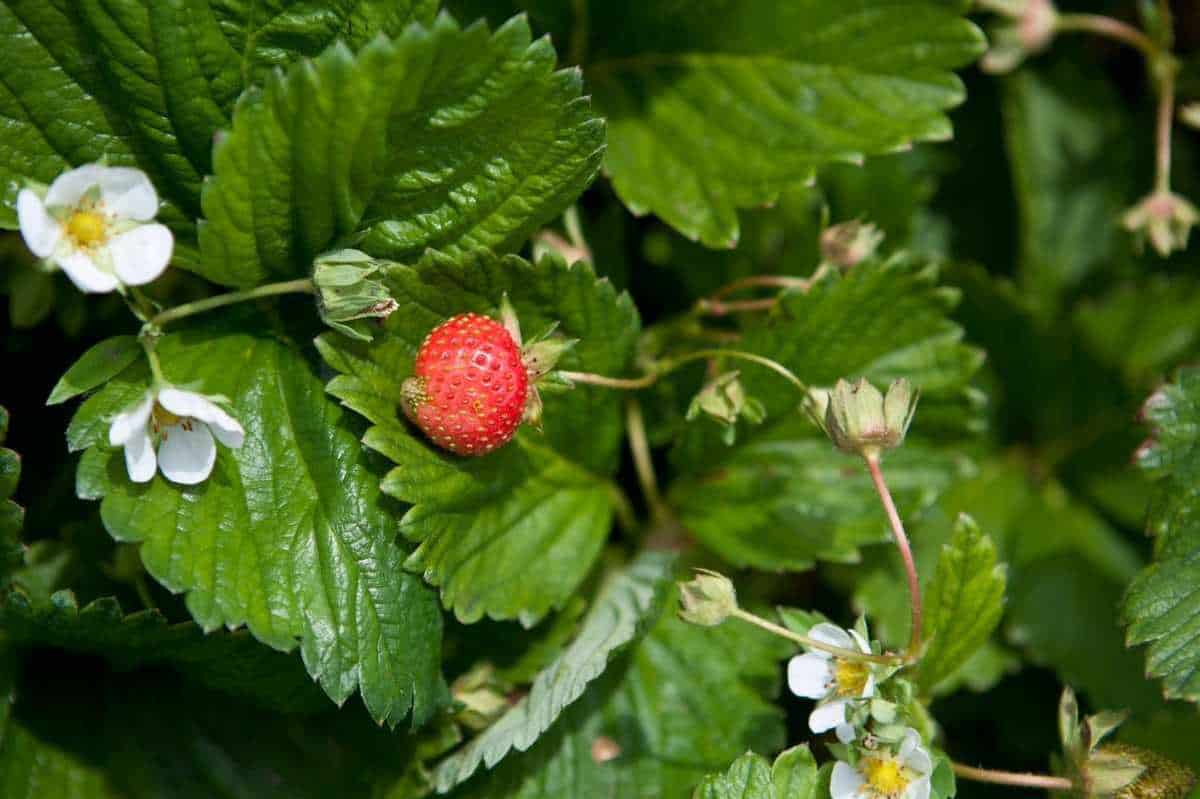
Table of Contents
Why should I grow strawberries?
Store-bought berries are large and juicy, but they’re often bland because they’re picked early to stand up better for the long transport to stores. Homegrown berries are something completely different. Nothing compares to the taste of homegrown strawberries. They’re usually not as large; however, what you lose in size, you more than make up for in flavor. Homegrown berries are bursting with sweet juices that make them perfect for fresh eating, preserves, and baked goods. Trust me; once you pop a homegrown berry in your mouth, you’ll never go back!
Growing your own can also be money-saving if you have the space to make a large strawberry patch. It’s easy to freeze strawberries and eat them all year long. And because strawberries are perennials and produce their own new plants each year (called “runners” or “daughters”), it is pretty much free to maintain your strawberry patch for decades!

Planning your strawberry patch
June-bearing, everbearing, day-neutral: which should I grow?
When shopping for strawberry plants, you’ll notice three different kinds—June-bearing, everbearing, and day-neutral. Pay attention to this because the type you choose will determine how your berries are grown and harvested.
The key difference between the strawberry varieties is when they’ll ripen. Some berries ripen early, while others ripen later in the season. Which variety you choose will depend on your growing season, what you plan on using your berries for, and how long you want your strawberry harvest to be.
- June-bearing strawberries are the most common berry for commercial producers. They ripen and produce one large harvest of berries in late spring or early summer (typically in June in many areas, hence the name). Then, they produce a flower bud in late summer to early fall that will bloom and grow flowers the following spring. June-bearing berries will produce small, flavorless berries in the first year if allowed to mature, so it’s a good idea to pinch any blooms in the first year to send energy to the plant’s roots. June-bearing is for you if you want a large volume to harvest at once to freeze strawberries, make strawberry jam, or otherwise preserve.
- Everbearing strawberries are berries that begin producing in early spring around the same time as June-bearing strawberries. What sets them apart is that instead of one large harvest, everbearing strawberries continue producing all season long. If the weather is mild, they can even continue to grow berries well into October! Everbearing strawberries need days that are at least 12 hours long to produce buds. Everbearing strawberries don’t produce nearly as much volume-wise as June-bearing strawberries, but they continuously produce.
- Day-neutral strawberries are very similar to everbearing strawberries. They produce fruit all summer long, from June through October. Unlike June-bearing and everbearing strawberries, day-neutral berries don’t require a specific day length to flower. They do require temperatures that stay between 40°F and 90°F. Day-neutral berries are becoming more and more popular with home gardeners because of their long growing season, large berries, and lack of dependence on day lengths.
Growfully Protip
Consider planting a few of each type of strawberries to ensure that you have fresh, plentiful berries all season long!
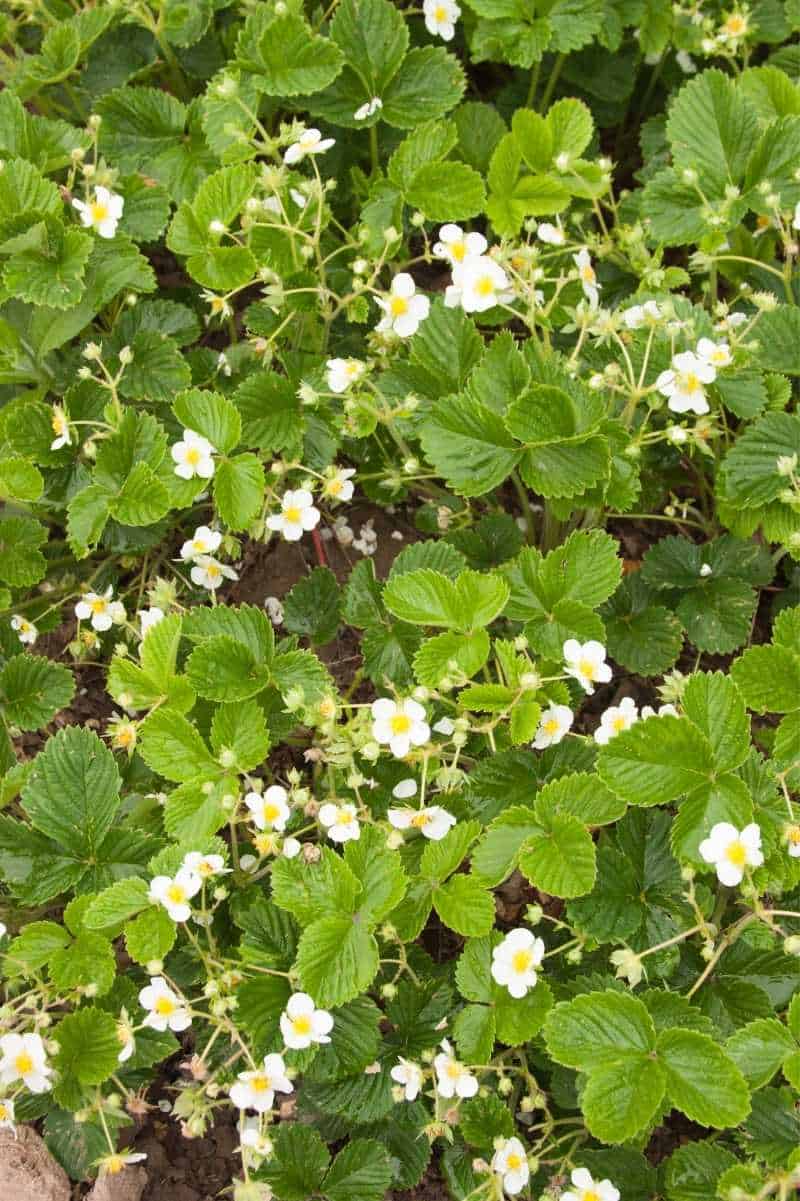
Where should I plant strawberries?
One of the most important considerations in choosing a planting location for strawberries is access to sunlight. Strawberries need full sun—at least six hours of direct sunlight a day, but preferably closer to 8-10 hours. This means they need to be planted in an area with no large trees, structures, or plants blocking their light.
In terms of soil, strawberries grow best in well-drained soil that’s sandy and rich in organic matter. They need a lot of water, but their roots will rot if left in standing water, so the soil must drain well. Like all berries, strawberries prefer a more acidic soil—thriving closer to a 5.5 pH, but they’ll grow happily in 6.5pH soils and even higher with regular acidifying.
You also have to consider what you planted in the prospective strawberry patch the previous five years. Strawberries are very susceptible to verticillium wilt—fungi that can overwinter in the soil. Unfortunately, many other plants such as tomatoes, peppers, potatoes, eggplant, roses, melons, and stone fruit are also susceptible to this fungus. Because of this, avoid planting the strawberry patch in an area where any of these other plants were in previous years.
Growfully Protip
You might be tempted to make a wide bed of strawberries—but you will be much happier with a narrow, long strawberry bed. Firstly, this makes it way easier to harvest your berries. Most importantly, strawberry foliage can get so lush in wide beds that the berries in the middle don’t get enough sunlight to grow big, flavorful, and juicy. We recommend strawberries beds that are no more than 24″ in width.

Will strawberries grow in shade?
Strawberries grow their juiciest fruit in areas with eight hours of direct sunlight. Strawberries grown in complete shade will grow very large leaves, and they’ll look healthy; however, they won’t produce flowers or fruit. Strawberries need a minimum of five hours of sunlight to grow delicious berries—any fewer, and they’ll either grow small, flavorless berries or no berries at all.
What’s the spacing for strawberry plants?
When you’re planning your strawberry patch, the type of strawberry you are growing will impact how you space out your plants.
June-bearing varieties produce tons of runners—long stems that grow a new baby plant at the end. Most people grow June-bearing strawberry plants in matted rows. To do this, space your original strawberry crowns about 18″ apart. As the plants produce runners during their first season, you set those runners around the main plant to fill in the open areas (making sure to pinch blooms as you do). By the second season, the bed should be filled in, and you can clip or transplant any extra runners that are produced.
Everbearing and day-neutral varieties are typically grown in the hill or mound method. You form a hill or mound of soil about 18-24″ wide. Then you pop your strawberry plants on the top of the hill. You clip off and remove or transplant any runners made (ever-bearing and day-neutral varieties don’t produce nearly as many runners as June-bearing varieties). This focuses the plant’s energy on setting roots and creating more flower buds and a larger crown on each plant.
Growfully Protip
Typically, the matted row method produces higher yields—more berries overall. The mound method produces fewer berries, but they are typically very large and high-quality berries.

How do you prepare the soil for strawberries?
Strawberries prefer a sandy loam that’s well-drained and rich in organic matter. To prepare the soil for strawberries, consider working in some peat moss, well-aged compost or manure, and some sand. If the soil is heavy or full of clay, you can improve drainage by adding some sand or by using a raised bed.
Growfully Protip
Like all berries, strawberries prefer a more acidic soil pH between 5.5 and 6.5. Consider acidifying your soil with sulfur before planting strawberries if your soil is alkaline. You can also regularly use an organic fertilizer than is acidifying—we like Berry-Tone from Espoma for our strawberries.
Do strawberries need a trellis?
No, strawberries prefer to sprawl out along the ground, sending their runners outwards to root in the soil and create new plants. If you try to grow strawberries vertically on a trellis, they’ll have nowhere for their runners to go.
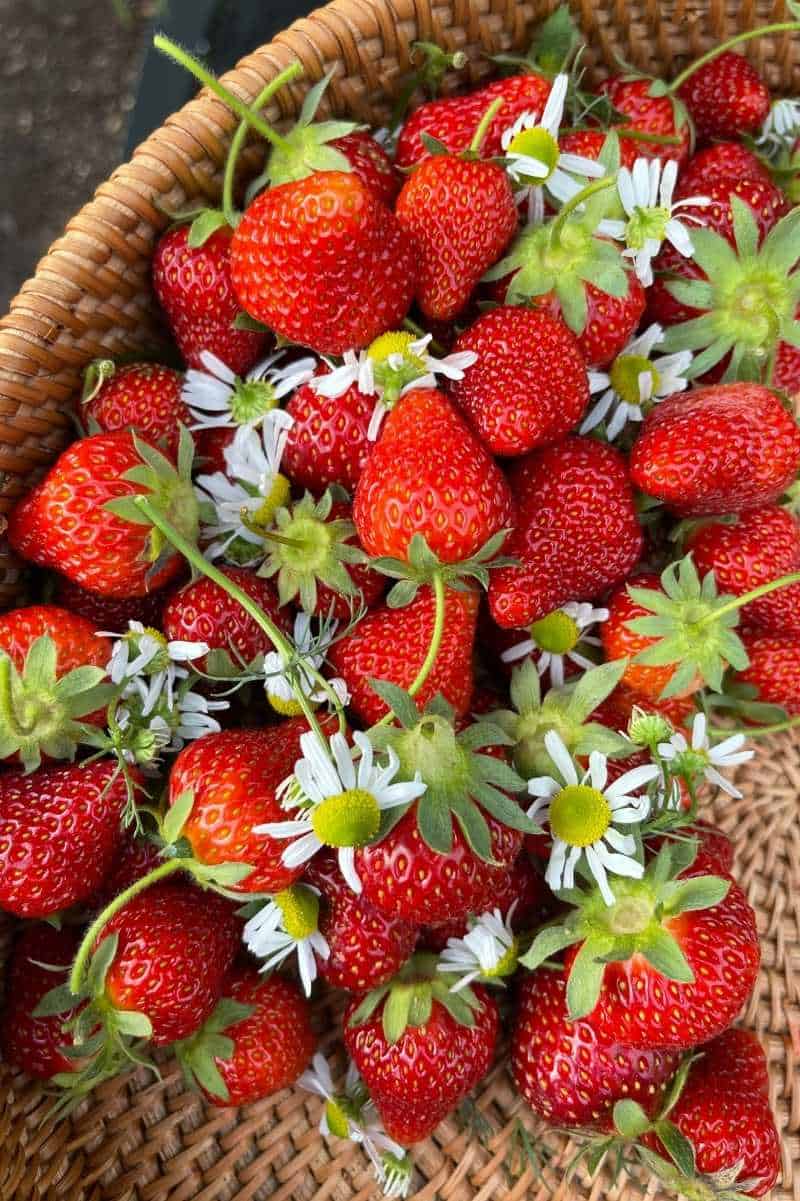
What should I plant near strawberries?
Several plants make good companions for strawberries, but because strawberries need so much space and sunlight, we recommend planting companion herbs and flowers around or near the strawberry bed rather than right in it.
- Herbs—There is a long list of herbs that do well next to strawberries. Sage, coriander, fennel, mint, and dill help repel slugs away from the strawberry patch. Borage may sweeten the berries while attracting pollinators to the plants. Thyme and caraway will deter worms and attract beneficial predator insects that keep away aphids, caterpillars, and thrips.
- Marigolds—The scent of marigolds deters many pests, so it’s a good plant for most gardens. In particular, marigolds deter root-knot nematodes that can damage strawberry plants.
How to Plant Strawberries
There are a few different ways to buy strawberries for planting. Most gardeners choose bare-root plants that are in a dormant stage to plant in the spring—this is the most affordable way to buy strawberries, and what we recommend. However, if you’re in a pinch, you can also buy strawberry starts or plugs from your local garden center or nursery for a premium price.
Growfully Protip
Before you plant strawberries, you’ll need to learn to identify the plant’s crown. This is precisely what it sounds like—a small part of the plant near the soil line that looks like a small crown.
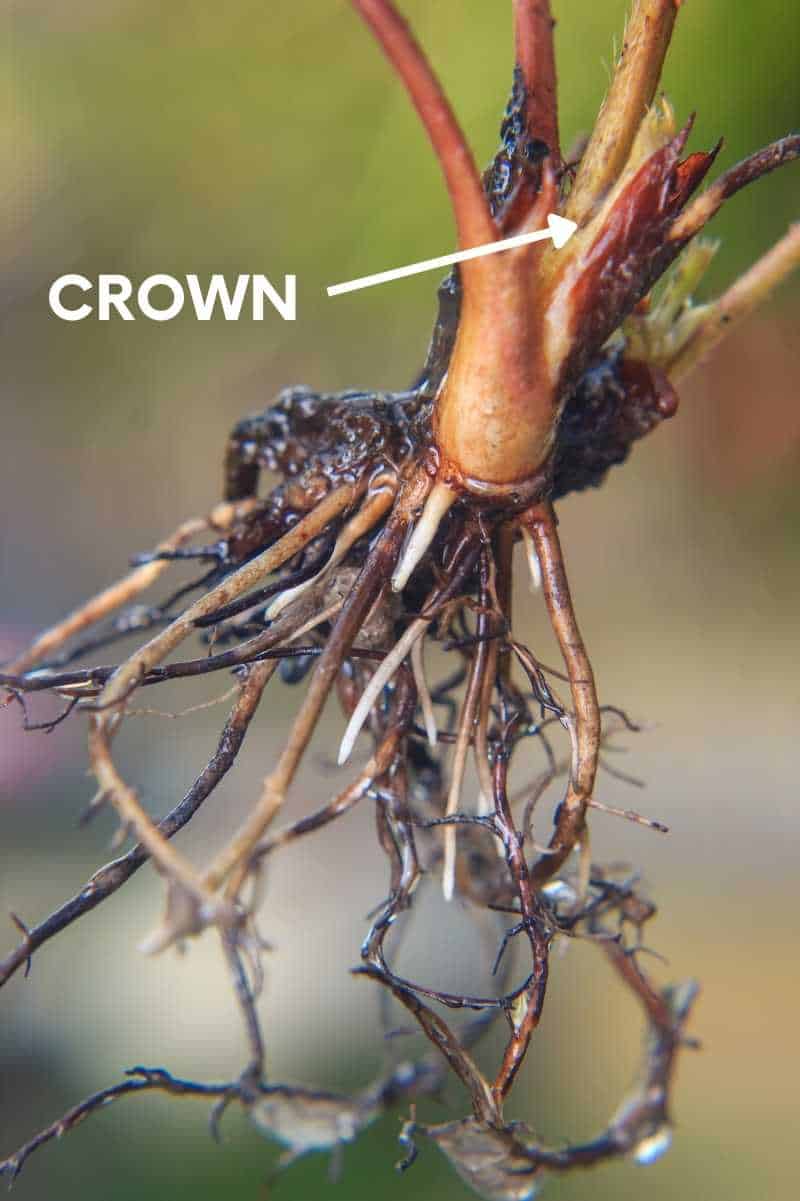
When to Plant Strawberries
Strawberry plants are pretty hardy! So you’ll be planting them out in your garden in early spring. When you pick up your strawberry crowns, they should still be dormant—honestly, they’ll look brown and dead. This dormancy means you can plant them outside in spring as soon as the ground has thawed and dried out. If you purchase young strawberry plants that have already leafed out, you’ll need to wait until after the last frost date for your area.
Spring isn’t the only time to plant strawberry plants. If you’re eager to harvest fresh strawberries in your first year, consider planting strawberry crowns in the fall to allow them time to develop a robust root system before they go dormant for the winter. The following spring, they’ll already have strong roots so they can pull water and nutrients out of the soil. This gives them a head start in the spring.
How to grow strawberries from bare-root plants

- Unwrap the bare root, dormant plants from their packaging. Soak them in room temperature water for 2-3 hours before planting.
- Dig a hole that’s deep and wide enough to accommodate the spread roots of the plant. Mound up the dirt in the center of the hole.
- Spread out the strawberry roots and lay them gently over the top of the mound with the crown facing up.
- Fill in the soil over the roots, so the soil line hits right in the middle of the crown—this is the one thing strawberries are pretty picky about. Do not bury the crown completely. Also, don’t have the crown completely above the soil line.
- Water well to help the plants establish themselves.
- Surround the growing plants with mulch. Many folks use clean straw (hence their name!), but we love fresh pine shavings for around our strawberries in the Growfully Gardens.
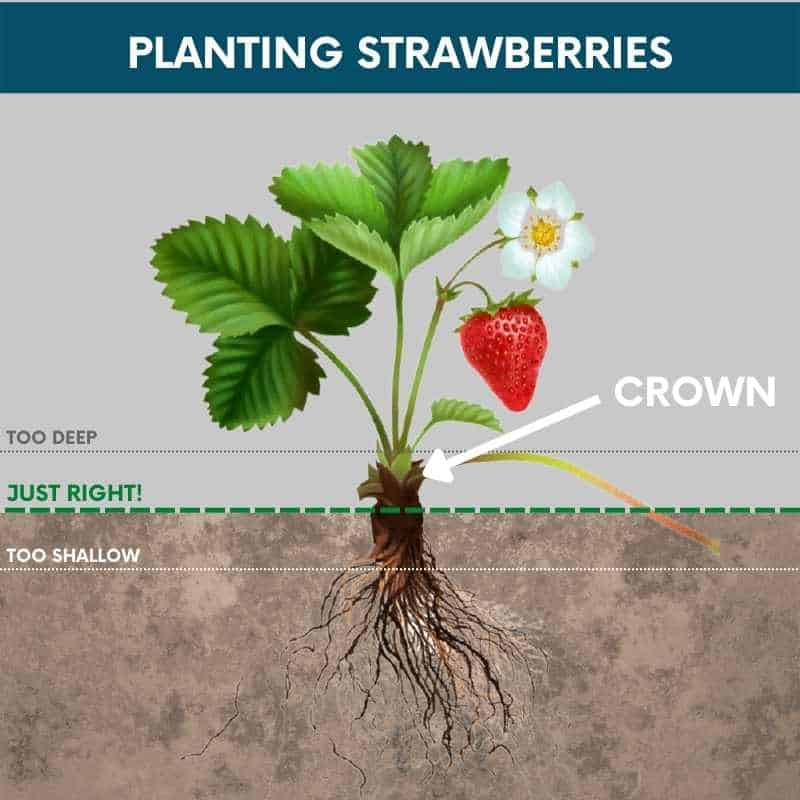
How to grow strawberries from starts or plugs
- Dig a hole deep enough for the root ball to fit.
- Set the root ball or plant in the hole and backfill.
- The top of the plant should sit just above the soil line.
- Water well and add mulch around the base of the plants.
How to Grow Strawberries
Once the plants are established, growing strawberries is pretty simple. Here’s what you need to know about watering, mulching, and fertilizing strawberries.
Download Printable Strawberry Growing Guide »
Watering
Strawberries need a moderate amount of water, but they don’t like wet roots. During the growing season, make sure the plants receive at least an inch of water per week, either through rainfall or hand watering. Once the flowers have bloomed, you can increase this to two inches of water, especially if the weather’s been hot.

Mulching
Mulching is the key to healthy strawberries. Strawberries have shallow roots and need steady moisture. Mulch helps prevent water evaporation, keeping soil moisture in. It also keeps the roots of your strawberry plants cool in the summer and prevents them from freezing in the winter.
It’s difficult to weed around strawberry plants because of their shallow roots, and mulch can help with this substantially. Mulch also keeps the berries clean and disease-free by keeping the fruit from contact with the soil and any bacteria or pests found there.
When choosing a mulch for strawberries, you can use straw, pine needles, or shredded leaves. Straw is a popular option (hence the name), but our favorite strawberry mulch is clean pine shavings.
Fertilizing
Strawberries are hungry plants, and they’ll benefit from some additional fertilizer throughout the growing season. We typically fertilize our strawberries twice a year with a slow-release fertilizer—once in the spring and once in the fall with Berry-Tone from Espoma. We also include our strawberries in our regular biweekly garden fertilizing with liquid fish emulsion and liquid kelp.
Growfully Protip
If you have alkaline soil like we do, your strawberries might benefit from a regular addition of acid. There are several ways to do this: soil acidifier, adding more evergreen organic matter to your beds, and using vinegar spray are popular. Our soil is very alkaline, so we do all three! We spray a dilution of 1/2 cup white vinegar to 1 gallon of water about once per month on our strawberries during the growing season.
The runners are taking over! What do we do?
One of the main things to think about when growing strawberry plants—especially June-bearing strawberry plants—is their runners. Very few plants produce offspring the way strawberries do—by shooting out long stems that create baby plants at the end. If you’re not careful, you’ll end up with strawberry runners popping up on your lawn, on your pathways, spilling outside their containers, and crowding out your production plants.

How you deal with runners will depend on your type of strawberry plant and your type of planting.
- For June-bearing plants in a matted row system: In the first year, as runners grow, place them evenly around the original plant (AKA: the mother) to fill in the open spaces. After the first year (or after all the spaces are filled), clip any new runners (AKA: the daughters) that develop. Either discard the runners, transplant them into a new bed, or give them to a friend.
- For ever-bearing and day-neutral plants in a hill/mound system or in containers: Clip all runners that develop so the original plant can focus on root growth. Either discard the runners, transplant them into a new bed, or give them to a friend.
How do I renovate my strawberries, and why should I?
After June-bearing (and only June-bearing!) strawberries are done producing, get out your mower and mow down those plants. Yup, you hear us right! Set your push mower to the highest setting and mow down all the foliage on the strawberry plants. This forces the strawberry plants to produce more flower buds in the middle of the crown, which makes for more fruit production in the following year. This needs to be done within about 30 days of the end of harvest to allow enough time for the foliage to regrow before the first freeze.
Growfully Protip
Do you have to renovate or strawberry bed? Nope. It’s an extra step that some folks do to increase their production. If you are happy with how your strawberries are producing and don’t want to put in the extra effort—go ahead and skip this step.
Get on a rotation schedule to keep your berries producing.
While strawberries are perennials, they are short-producing perennials. Strawberry beds will remain productive for three to five years before the berries get smaller and decline in quality. Don’t despair! The great thing about strawberries is that they continuously produce new, fresh plants for you to use (those pesky runners!). We recommend getting in a rotation where you plant a new bed, planter, or row of strawberry plants from runners each year. Those plants will come into full production in 12 months, and you can phase out the original set of plants when they slow down.
If you have the space, a four-bed/row strawberry rotation system works really well:

- Year 1: Plant bed A with new bare root strawberry crowns
- Year 2: Harvest from bed A, plant bed B (with runners from bed A)
- Year 3: Harvest from beds A and B, plant bed C (with runners from bed B)
- Year 4: Harvest from beds A, B, and C, plant bed D (with runners from bed C)
- Yeah 5: Harvest from beds B, C, and D. Remove all plants from bed A and replant (with runners from bed D).
- Repeat!
Growfully Protip
If you have enough space to add a fifth bed or row, you can also add a year of cover-cropping into your rotation to make sure to add back depleted nutrients between strawberry plantings.
Harvesting Strawberries
Will strawberry plants produce fruit in the first year?
Yes, all strawberry plants will produce fruit in their first year, but it’s not recommended you let them. We highly (HIGHLY) recommend pinching all blooms on your plant in the first year. We know it’s hard, but you’ll have small, misshapen, flavorless berries and weak plants if you leave the blooms on. Pinching blooms allow strawberries to focus their energy on growing strong roots—you’ll have more vigorous plants and larger berries the following summer. This is especially true of June-bearing strawberries, which need a longer time to become established before fruiting. But we also recommend pinching first-year blooms for ever-bearing and day-neutral berries.

How many years does it take for strawberries to produce fruit?
Everbearing and day-neutral berries can produce fruit in their first year. We recommend that you pinch the first blooms on these plants to encourage the plants to send energy to the root system. That being said, everbearing and day-neutral berries have multiple harvests throughout the year. So, you can pinch the first few blooms and still have a late summer harvest of these berries.
June-bearing strawberries should always have their first year’s blooms pinched to produce a healthy plant. If you’ve chosen June-bearing strawberries, you can expect a harvest in their second year.
How to harvest strawberries
Strawberries are very easy to harvest. They’ll often be hiding below the shiny green leaves of the plant, so you’ll have to lift all the leaves to find all the berries. Harvest the strawberries when they’re a bright red by twisting them gently from the plant. Avoid letting them develop to a dull, dark red, as this means they’re past their prime. You’ll harvest June-bearing strawberries once, everbearing strawberries a few times, and day-neutral strawberries all summer long from June through September.
Winter Care of Strawberries
Strawberries don’t actually die in the winter. They go into a period of dormancy where they have very few needs and conserve their energy. Then, in the spring, they burst into life once more.
If you live in a warmer climate, your strawberry plants will require very little care over the winter. If you live in a cooler climate, wait until your plants have gone dormant and the first few inches of soil freezes. Next, put a heavy layer of mulch over the berry patch—about 6″ in milder climates or up to 18″ in very cold climates. Straw or pine shavings work best for this because it’s lightweight and will protect the berries from freezing temperatures.
In the spring, pull the mulch away from the plants to allow the sunlight to bring them out of dormancy.
Growfully Protip
Strawberries will survive a frost! The frost won’t hurt the plants unless they’re flowering. Once buds have formed or flowers have opened, the plants are susceptible to frost damage, and you should cover them if you know low overnight temperatures are coming.
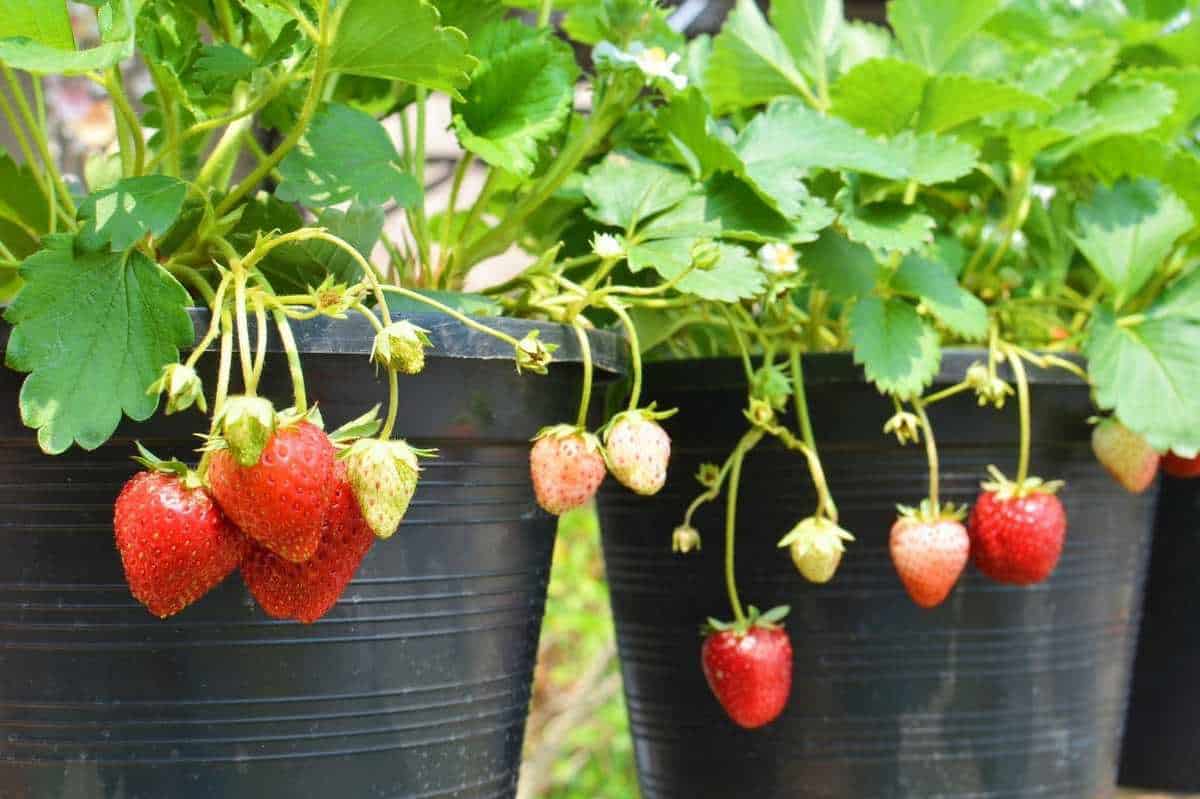
Growing Strawberries in Containers
How to Grow Strawberries Indoors
Yes! Believe it or not, strawberries can grow indoors to provide fresh juicy berries all year long. Before learning how to grow strawberries indoors, there are a few things to keep in mind.
Strawberries require at least six hours of direct sunlight. That’s the equivalent of 12 hours under an indoor LED grow light. They have shallow roots, so you won’t have to worry about finding a deep pot.
Everbearing and day-neutral berries are the best berries for indoor growth because you’ll be able to benefit from your control over the growing environment to get multiple harvests. Alpine berries are smaller than other berries, so they’re great candidates for indoor growing.
One this to keep in mind is that there are no pollinators indoors. This means that you might have to hand pollinate your strawberry flowers. You can do this by using a small paintbrush or makeup brush to spread pollen from the outside yellow male part of the flower to the inner yellow female part of the flower.
How to grow strawberries in pots
Strawberries grow well in pots because they don’t take up a lot of room, you can better control the amount of sunlight they receive, and you can provide your berries with excellent drainage. Sometimes berries grown in pots produce less fruit than those grown in the garden.
You can plant three strawberry plants for every square foot of soil. Any more than that, and they won’t have enough room to grow. Ensure the pot you choose has excellent drainage and place it in a sunny location. Don’t allow the pot to dry out, but try to avoid over-watering as well.
Snip any runners your strawberries send out. They have nowhere to root, so clipping them allows the strawberries to focus their energy on producing more berries instead of new offspring. Try to keep your strawberry roots cool by choosing a light-colored pot and spritzing the sides with water to pull some heat away from the plant.

What are some alternative ways to grow strawberries?
There are dozens of ways to grow strawberries outside of a garden bed or garden row! Of course, you can just put them in a regular pot, but there are also some amazingly creative ideas out there, too. The majority of these will be best for ever-bearing or day-neutral plants, so keep that in mind when you’re plant shopping. Here are some of our favorites we’ve seen:
- Growing them spilling out of hanging baskets on your porch or patio.
- Using them as a border plant in large decorative planters.
- Using a sunny window box or deck box for easy-to-grab berries in a moment.
- Upcycling old gutters attached to a fence or wall for out-of-the-way strawberry containers.
- Filling up a classic strawberry pot on your porch or patio.
- Use stacking pots to create a strawberry tower.
Growfully Protip
Whatever container you use to grow your strawberries, make sure they have suitable drainage holes!

Troubleshooting
Companion planting, proper watering, regular weeding, and mulching will all help avoid issues with pests and diseases. If you are struggling a bit, here are some common issues to watch out for:
Pests
- Slugs leave tiny circular holes in strawberries, especially around the tops. You can trap these pests using old boards, newspaper, and slug traps at night to be disposed of the next day.
- Strawberry sap bugs are very tiny dark oval insects that eat holes in ripe—and overripe—fruit. Picking your fruit when it’s ripe and getting rid of any berries that have fallen to the ground will deter this pest.
- Tarnished plant bugs are tiny winged insects that are only a ¼ inch long. These pests will lay their eggs in early spring on strawberry buds. When the larvae hatch, they’ll feed on the new fruit, causing misshapen berries. Cut down on weeds, use white sticky traps, and plant companion plants that attract beneficial predator insects to eliminate this pest.
- Strawberry bud weevils are a problem in early spring, when they will suck the pollen out of closed buds before laying an egg. The egg prevents the bud from opening, leading it to fall off. Check for weevils when buds are forming and remove any affected buds. A spray of insecticidal soap might be helpful as well.
- Spittlebugs don’t often kill a plant, but they suck the sap out of the stem and leaves, stunting the growth. You’ll know you have spittlebugs if you see white foam around your plants. Remove any you see using a steady stream of water and cover young plants with floating row covers to stop pests from laying eggs.
- Birds will try to get to the berries. Keep them out by spreading bird netting over the strawberry patch. You can also paint rocks to look like strawberries and set them around the outside of the patch to confuse the birds and direct them away from the real treat.
Diseases
- Angular leaf spot is a disease caused by water sitting on the leaves and looks like tiny dots on the plant’s leaves. Avoid overhead watering and only water in the morning to cut down the risk of this disease.
- Leaf burn shows as dark brown or purple spots on leaves that may spread to the fruit and flowers of strawberries. This can cause the flowers and berries to drop off the plant. Look for resistant varieties of strawberries and make sure there’s enough air circulation between plants to avoid this disease.
- Anthracnose displays as dark circular lesions that develop on the berries and leaves. Although it’s rarely deadly to the plant, it can kill off the berries it infects. You can prevent this fungus by planting disease-free transplants, washing soil from the crowns of your plants before planting, and avoiding high nitrogen fertilizer.
- Grey mold is a large fuzzy mold that spreads on wet leaves. Use a thick mulch to prevent fruit from touching the soil and avoid watering from above to avoid this disease. Once it’s taken root, the best option is to remove all diseased fruit to prevent it from spreading.
- Verticillium wilt is a fungal disease that first shows up with curly, brown, dried leaves on the strawberry plant. Unfortunately, once verticillium wilt has taken over, it’s nearly impossible to control. You’ll need to remove and destroy all plants and consider changing your soil (if growing in raised beds or containers) or using a strong organic fungicide on the soil.
Download Printable Strawberry Growing Guide »
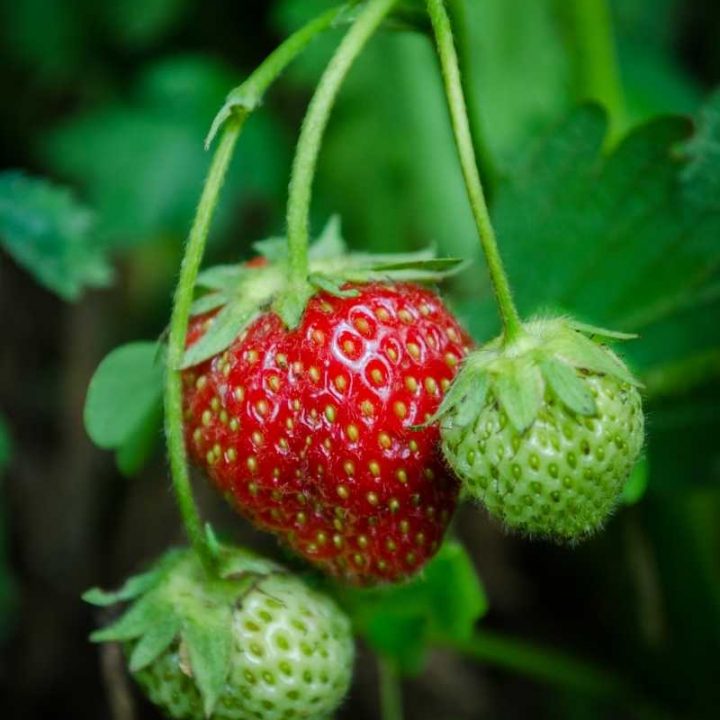
How to Grow Strawberries
Materials
- Strawberry crowns or bare root plants
Tools
- Acidic soil
Instructions
- Clip blossoms the first year. This will force the plants to put energy into building strong root systems, guaranteeing bigger, more flavorful strawberries in future seasons.
- Control runners. Strawberries (particularly June-bearing varieties) produce "runners," which are small plants that come off the main plant. Once your patch Is filled in, remove any extra runners to avoid overcrowding.
- Keep the bed narrow. A narrow strawberry patch will produce bigger, more flavorful berries because the canopy of leaves in a broader bed can prevent berries in the middle of the plants from getting enough sun.
- Renovate June-bearers. June-bearing varieties perform better if renovated after harvest each year. Immediately after harvest, mow the plant down to just above the crowns. Weed well and fertilize. The plants will come back even more lush before the first freeze, leading to more berries next year.
- New plants regularly. Production quality of all strawberry plants considerably declines after 3-4 seasons. When production drops, replace all plants (either with new plants or runners from previous plants).
- Protect the crown in the winter. After the first fall freeze, remove all the dead foliage and then cover the crowns with mulch (pine shavings or straw, hence their name!) to protect during winter.
- Acidify the soil. All berries prefer acidic soil, and strawberries will benefit from soil that is amended to be in a pH range of 5.0-6.0.

